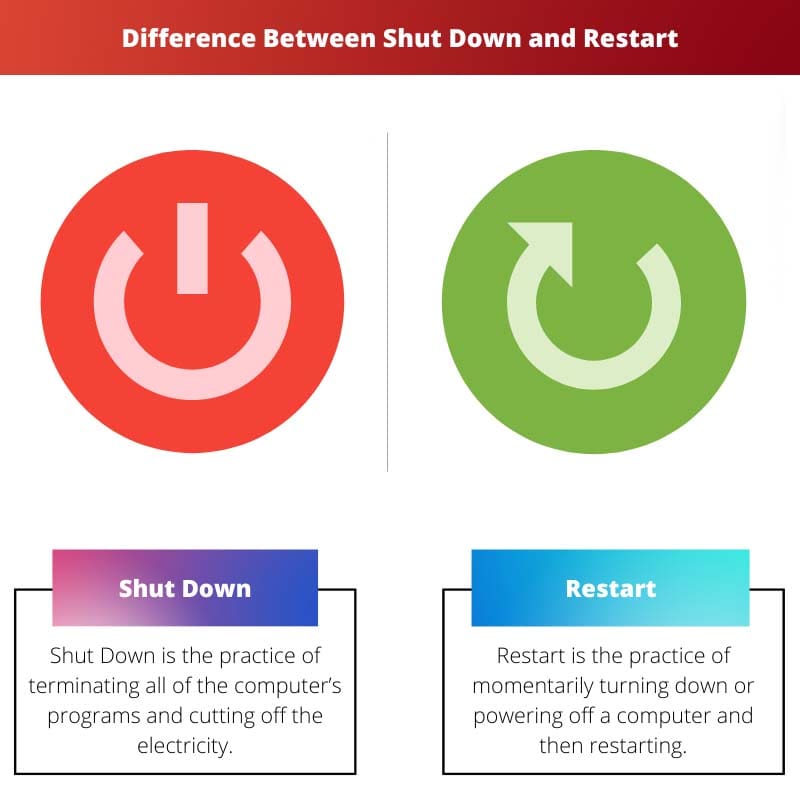When we read English, we encounter a large number of terms; some are used in general, while others are specific to specific situations.
For example, if we consider a computer, which is an electrical machine that performs a variety of tasks, two words are frequently used concerning computers: Shut Down and Restart.
If we Shut Down the computer, it will be entirely turned off, and if we Restart the computer, it will be briefly turned OFF and ON again.
In simple words we can say Shut Down cuts the power completely and in Restart the power is cut off temporarily.
Key Takeaways
- Shutting down powers off the computer and closes all applications and processes, which conserves energy and allows for hardware maintenance.
- Restarting reboots the computer, refreshing the operating system and clearing temporary files, improving performance, and resolving minor issues.
- Choose to shut down or restart based on your needs, whether conserving energy, performing maintenance, or troubleshooting problems.
Shut Down vs Restart
Shutdown is the process of turning off a computer or device completely. Restart is the process of shutting down the computer or device and then turning it back on. Restarting a computer can fix minor issues and refresh system resources, while shutting down is for when not in use.

Shut Down is the practice of terminating all of the computer’s programs and cutting off the electricity. The computer’s operating system is the final program to be closed.
To avoid data damage, it is critical to Shut Down the computer appropriately. The user could be surfing the web, writing word docs, using Dreamweaver, playing a game, or writing a computer program.
The user can turn off the machine once the duties have been completed.
Restart is the practice of momentarily turning down or powering off a computer and then restarting. It is required for things like updating the computer and installing new applications.
Restarting the computer allows you to double-check that the updates were installed appropriately. It also guarantees that the software performs as expected.
Comparison Table
| Parameters of Comparison | Shut Down | Restart |
|---|---|---|
| Synonyms | Power Off | Reboot |
| Power | No Power | Restart without interrupting the power |
| Use | If you have finished your work and want to preserve energy | To fix any issue, or if you have recently downloaded updates or software applications, |
| Operating system | The operating system builds a list and sifts across it to deliver a shutdown signal to all open programs. | Operating System Restart all applications |
| Time Taken | Less time | More Time |
What is Shut down?
Shut Down refers to the process of terminating all software programs on a computer before turning it off.
Whenever you Shut Down the computer, all of your software, programs, documents, and activities are terminated, and the RAM is cleaned.
It is critical to backup all of your work before shutting down your pc, because it will not reopen whatever you had worked on before closing down. Shutting down the system also frees up RAM, allowing it to function more smoothly.
Shut Down is the main function in a computer that is beneficial for the computer in various ways, such as:
1) System Problems: When computers are left on for a long time, it tends to perform strangely or develop minor faults. That’s because certain programs have been running or have been consuming RAM.
Shutting down your computer regularly can assist prevent these problems from happening.
2) Life Extension: You place the computer at greater risk by not shutting it off. This exerts a lot of strain on the computer’s components, reducing their lifespan.
3) Saves Energy: To save electricity, turn off your computer regularly. This not only saves your wallet by lowering your electric cost, but it also benefits the environment.
What is Restart?
When we Restart the device it effectively stops all processes and Restarts them with a new boot on the motherboard base. This explains why restarting your system is a time-consuming process in contrast to switching it off and on directly.
When the system is restarted, the reboot System operation Restarts one of your network’s computers.
You can arrange the Restart system action to either wait for all existing programs to close down appropriately or forcefully close all active applications.
It is advised that you Restart your system if you have an issue with it.
Although it may appear to be a simple procedure, Restarting your computer can resolve the connection, graphics, speed, and program faults.
Restart is one of the most useful features on a computer that is carefully designed to resolve some common issues that you face on your computer. The following points show the benefit of Restarting a computer:
1) Issues with RAM or Slowness: Clearing the RAM cache is among the most prevalent causes to Restart your system. Your system has decades of technological developments, one of which is known as RAM, even though they aren’t being used, part of this data accumulates as they operate. The Restart option helps to clear this unused RAM.
2) Access to the Internet: If your Wi-Fi isn’t working, try Restarting it! A typical reason to restart your system is a loss of internet connectivity.
3) System Updates: Updates fixes and updates keep your machine running, when you update or download software, the system must be rebooted to take effect.

Main Differences Between Shutdown and Reboot
1. A Shut Down function controls the removal of electricity from a computer’s primary components. Whereas, Restart flushes your computer’s memory before closing down or updating apps.
2. The system is turned off entirely with the Shut Down function. Whereas, Restart turns off the system and then turns it back on.
3. Shut Down is a preferable alternative for reducing power usage and extending the battery’s life than Restart.
4. In the case of security, Shut Down is a better option as compared to Restart because shutting down the system eliminates the possibility of it being hacked and prevents it from connecting with a direction and command server.
5. A Shut Down is also referred to as “Cold Boot,” whereas a Restart is referred to as “Warm Boot.”.

- https://www.sciencedirect.com/science/article/pii/S2214157X18300650
- https://www.sciencedirect.com/science/article/pii/S0920410511000830
